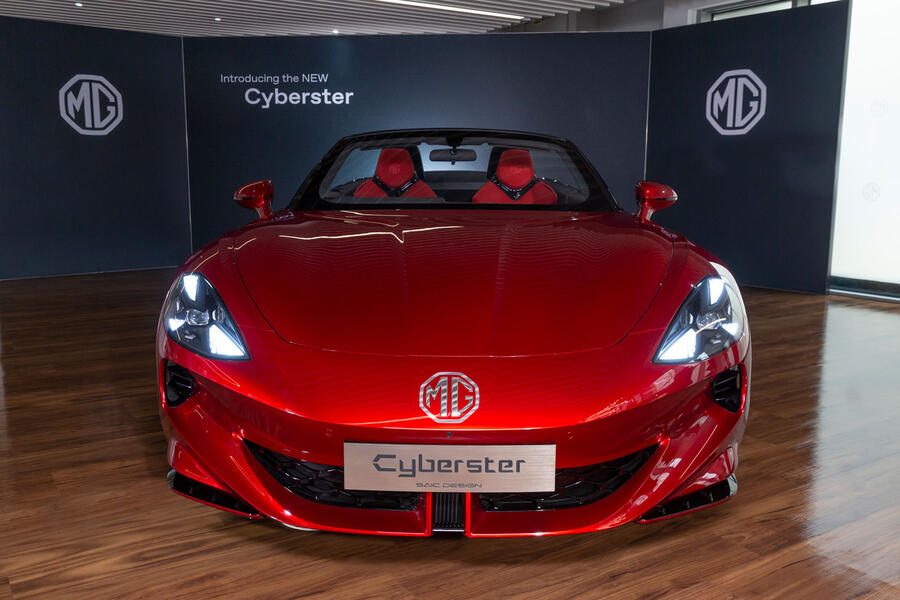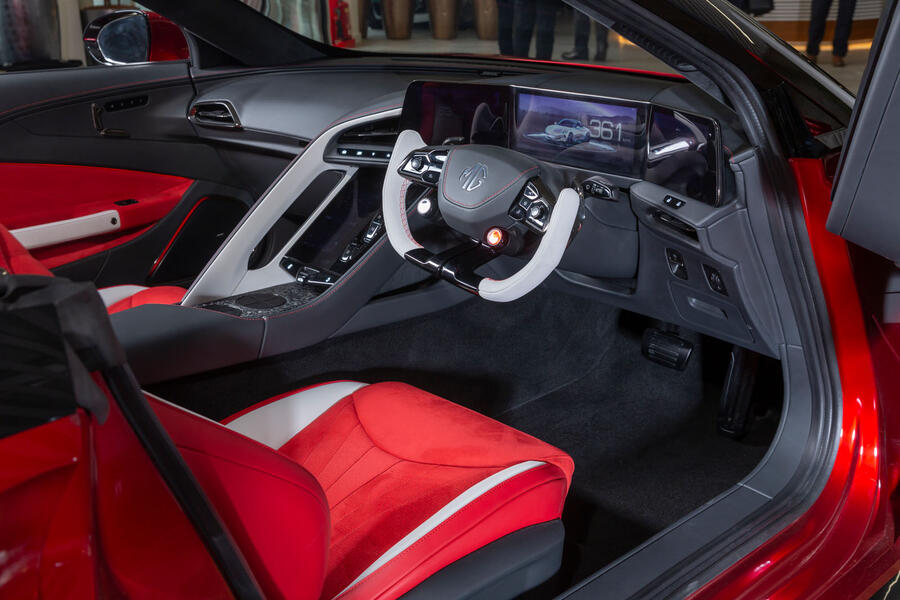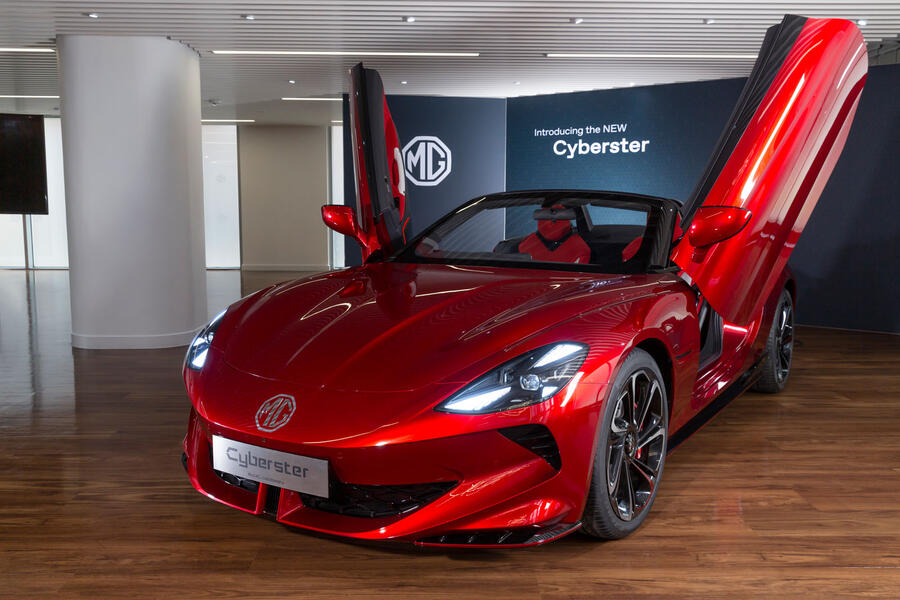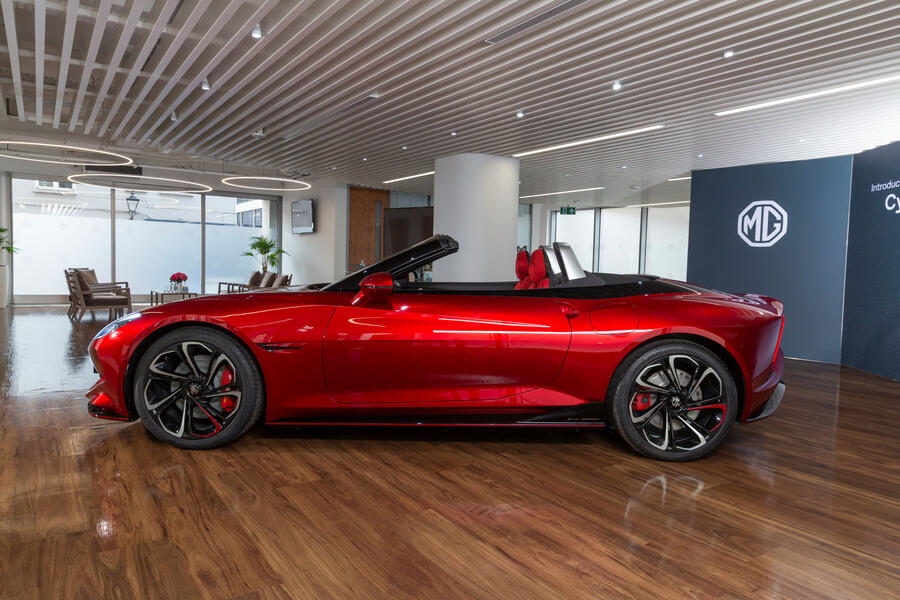Convertible gets up to 536bhp and is touted as world’s first 'affordable' EV roadster
MG, the British sports car marque acquired by Chinese owner SAIC soon after Longbridge-based MG Rover collapsed in 2005, has taken a giant step towards reconnecting the marque with its century-old roots by staging a London unveiling for its Cyberster fully electric sports roadster, due in showrooms next summer.
The car, launched as a near-production concept last month at the Shanghai motor show, is the first all-new sports roadster to carry the iconic octagonal MG badge since the MG F in 1995.
MG claims it will be the world’s first “affordable” EV roadster, dramatically undercutting existing electric performance cars with a two-model structure likely to begin around £55,000 for a rear-wheel-drive 309bhp version and stretching to around £65,000 for a four-wheel-drive, twin-motor version with 536bhp.
Although the car was originally planned as a replacement for the MG TF (a developed version of the MG F), the need to carry a large traction battery and the consequent requirement for a long wheelbase has made the Cyberster closer in its major dimensions to the 4.4m-long BMW Z4 than its 3.96m mid-engined predecessor.

Little has been confirmed about the Cyberster’s mechanical layout ahead of its official Goodwood Festival of Speed launch, but the lighter single-motor model is understood to tip the scales at around 1850kg – 750kg more than the MG TF. The twin-motor model is expected to add 135kg.
The new EV roadster, which for the time being will be built only as an open-two-seater with an electric-powered folding roof, has a wide and spacious cabin, helped by the lack of engine in the nose. The batteries are located in the chassis on a 'skateboard' principle.
Like the Cyberster’s exterior, the interior designs have their roots in MG’s London-based advanced studio. The plush fascia and instrumentation take influence from contemporary gaming trends and scissor doors provide what designers call “a sense of theatre”.

MG design director Carl Gotham, leader of the brand’s 20-strong advanced design group based in London’s Marylebone, acknowledges the size growth but believes the car wears it well, “creating a completely new kind of roadster ready for a new generation of sports car drivers”.
He cites the Cyberster’s main aim as being to lead the design style of future MG models. MG will continue its concentration on SUV and estates, but this will not be its only sports car.
MG UK commercial director Guy Pigounakis says the company has already been “inundated” with requests from potential buyers and says MG’s British dealers (soon to number around 150) are equally enthusiastic.
Chasing volume is not the Cyberster’s main function, he insists. It will primarily be an image-builder though he “could imagine” UK volumes around 2000 units a year when demand settles.
Pigounakis cites great value for money and excellent new car distribution as important elements in MG’s success but reckons brand recognition is a “critical” part. And response to the cars from older buyers is “absolutely phenomenal”. He said: “It’s clear there’s a large and active group of buyers who remember the excitement and the promise of the MG name and have a huge amount of affection for it.”
MG’s UK sales have been booming for years, and in 2022 it exceeded 51,000 units, more than five times their level five years ago. Recent growth for MG across Europe has been even more spectacular: sales were below 1000 units in 2019, yet they are expected to hit 120,000 by the end of 2023.
Q&A with Carl Gotham, MG's head of design
Carl Gotham trained in design at Coventry University in 1999, joined MG a decade later and worked in both interior and exterior design before being appointed to his present position in 2017, and setting up the Marylebone advanced studio in 2018. Its work, he says, has “all been building up to this.”
How did the Cyberster project start?

"The idea of a new sports car always existed at MG, and when I joined, I did my best to push it. At first, it was a kind of skunk-works project. Then when I took over in 2017, it became one of my first jobs. There were lots of different ideas, but the plan for an EV roaster felt very relevant. When we moved to Marylebone, the project acquired a specific brief – to have a future-oriented roadster concept ready for Shanghai, which is what we delivered."
What was the detail of the brief? And was the work done in the UK?
"The car had to be a statement of intent about the company’s future. It had to be curvaceous, warm and approachable but it had to fit the brand, too. We knew it had a lot of great cars to live up to. The exterior was designed 100% in the UK, but more of the interior and fascia was done in Shanghai."
How free were you and your team to design the car you visualised?
"We were pretty free. Part of our job is to study and try to predict trends, and we’ve been reasonably successful at it. The MG 4 was done in the UK in concept, then finalised in the Shanghai studio and that has been successful. Our brief is to work on models three to four years ahead."

As an EV, the Cyberster clearly has to be bigger than past roadsters. What were the positives and negatives?
"The positives were things like cockpit space, pedal space and the excellent weight distribution of a car with its battery weight so low in the chassis. The negatives were things like the seat height (the battery effect). Also the long wheelbase and the sheer size. But we believe that when you look at Cyberster, or drive it, you don’t see compromises. It’s a holistic design."
Tell us about your experiences as a design director in the EV era, coping with so many changes.
"As things advance, you keep seeing unanswered questions, because the challenges are very disparate. You’ve got to respect a great brand heritage, even though so many transitions are affecting basic vehicle design. You’re also designing for very different customers, too, those here and those in China. Trying to do all this really helps you stay ambitious."